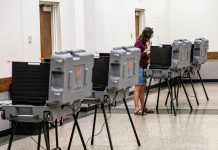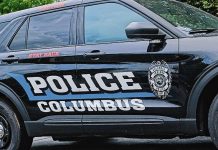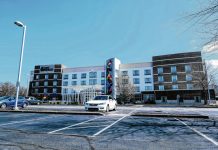Nearly 20 projects are in design or construction phases to make the Columbus People Trail system safer and more accessible to city residents.
At least 14 miles of trails that are either in the planning or working stages would be added to the city’s 27-mile trail system. Additions will take shape in the forms of side paths, trail connections and extensions and bike lanes, which will be placed in nearly all areas of the city, city officials said.
Some of the projects will be completed this year while others will be years off.
The expansions, being guided by the Columbus Park Foundation, are all part of an effort to promote physical activity in all neighborhoods while also providing safe routes to school and work, said Dave Hayward, executive director of public works and city engineer.
[sc:text-divider text-divider-title=”Story continues below gallery” ]
“Anything we can do to get people out and being active is good for the community,” said Hayward, a lifetime park foundation board member and a past board president.
People use the People Trail system for recreation, exercise, transportation and to socialize.
Michele Freed of Columbus said she regularly uses the trail near her house for walks and runs. Sometimes, her runs turn social because of how many familiar faces she comes across, Freed said.
In fact, the People Trail system played a big part in which house the Freed’s family chose when they came to Columbus 18 years ago, she said.
“I was not crazy about the shape or design of my home, but I bought it because we were right across the street from a People Trail,” Freed said.
Freed, who works at Columbus Regional Hospital, sometimes walks on the trail near her work. She and her friends also use the trails for weekly group recreation.
“On Saturday afternoons, a big group of us will either walk Noblitt Park or the People Trails by us or the one at the corner of Marr and Rocky Ford roads,” Freed said.
Other users can be seen running, walking their pets or biking at any given time throughout the day.
Three main factors were considered in deciding where to expand the trail system, Hayward said:
Bringing trails closer to neighborhoods that do not currently have easy access to trails.
Increasing resident safety
Meeting increasing transportation needs
Old bridge, new purpose
One of the city’s biggest most ambitious expansion projects, and one of the most costly at $500,000, is under construction at 25th Street. The Haw Creek Trail Realignment has been in the planning stages since 2010.
The new stretch, which is safety based and will allow users to pass below 25th Street to avoid busy traffic, is expected to be completed by Sept. 30, said Mark Jones, director of the Columbus Parks and Recreation Department.
“Those sidewalks on the bridge itself are extremely narrow,” Jones said.
Jones has observed trail users fall off the sidewalk when trying to pass someone coming from opposite direction, he said.
Leslie Weaver of Columbus, who runs or bikes the trail on nearly a daily basis, said she has had a number of close calls with the traffic.
“It’s a busy street with four lanes and cars turning in and out of businesses. And the cars aren’t always paying attention,” Weaver said. “I’ve had cars almost hit me many times or honk even though I have the right of way.”
Other than her own safety, Weaver, who is a teacher at Columbus North, worries when she sees students riding to school and crossing the road or riding on the narrow bridge.
When Weaver and her husband heard the new section was coming, they were excited. Now that they can see the work in progress, Weaver said they can’t wait for it to be completed.
Work began May 22, when a five-block section of the existing trail south of 25th Street was closed to allow crews to install rock on both sides of Haw Creek to guard against erosion, said Casey Ritz, Columbus Parks and Recreation Department director of park operations.
Nine days later, another section of the trail that extends from 25th Street north to 30th Street was also placed off-limits, Ritz said.
Both sections will remain closed while workers install concrete sidewalks from the existing trail to where the former Newbern Bridge will be reassembled late this summer, assistant city engineer Andrew Beckort said.
The 106-year-old former Newbern Bridge will be utilized by bicyclists, joggers and walkers to cross Haw Creek, forming a short extension to the trails system.
Cranes lifted the historic structure from its foundations on both sides of Clifty Creek near the Newbern United Methodist Church in February 2015.
As the old bridge was disassembled, labels were placed on each part before being transported to a fenced-in area next to the Lincoln Park maintenance shed, historic bridge consultant D. Eric Brunn said. But upon closer examination, some metal parts were more deteriorated than originally believed, said Brunn, an engineer with Strand Associates who has been involved with the Newbern Bridge project for 18 years.
Those parts are currently at a specialty metal shop in northern Indiana for grinding and heating, which will eliminate multiple forms of rust and deterioration, Brunn said.
Once the repaired metal is shipped back to Columbus in August, work can get underway to reassemble the bridge across Haw Creek, Beckort said.
But even when the bridge begins carrying non-motorized traffic this fall, a few finishing touches will have to be added until it can be considered complete in June 2018, Beckort said.
Projects near schools
Another trail expansion is planned at Parkside Elementary. Out of concern for child safety during busy drop-off and pick-up times throughout the school year, updates to the trail were needed, Jones said.
The new addition will create a loop away from departing and arriving car and bus activity so students can get to school more safely. It will also provide direct access to Blackwell Park and Freedom Field Playground, the largest accessible playground in Indiana, according to the project’s description. This extension is also expected to be complete in the fall.
A second elementary school expansion is under way at Richards Elementary, where the biking situation is different from Parkside, Hayward said. Richards students don’t have a safe way to arrive via sidewalk or trail, Hayward said.
According to the project description, Richards students living in neighborhoods less than a third of a mile away are required to ride a bus because no trail is available.
To fix the issue, a 1,700-foot long side path will be added along the east side of Par 3 Drive from Rocky Ford Road to the school, along with pedestrian flashers to alert drivers on Rocky Ford Road.
“That’ll be a big improvement and should allow a number of kids to walk or bike to school that currently can’t,” Hayward said.
In addition to safety for students and parents, the side path and included sidewalks along Rocky Ford Road will provide additional access to Par 3 Golf Course, as well as provide a place to walk and exercise.
Paying for improvements
The estimated total cost for these projects is about $3.7 million.
Funding for trails has come from an array of sources, including a four-year total of $140,000 donated to the Columbus Park Foundation from the annual Mill Race Marathon, Hayward said. Not all of this funding has gone directly into the People Trail system, as some has gone to other foundation projects such as ColumBIKE, he said.
Some money — such as what will be used for the Parkside and Richards additions — falls under the federal Safe Routes to School program, Hayward said. Under Safe Routes to School, the federal government will cover 90 percent of project costs, leaving only 10 percent of the cost to be picked up locally.
“It’s a great deal for us if we can capitalize on those funds. Sometimes its just being opportunistic with the projects and finding the right fit,” Hayward said.
[sc:pullout-title pullout-title=”People Train expansion projects” ][sc:pullout-text-begin]
Here are People Trail projects that are either underway or in planning stages, with estimated costs.
Further information on each project can be found online at columbusparkfoundation.org/the-people-trail-project/.
Taylor Road Sidepaths — Where: From U.S. 31 to 25th Street. Cost: $500,000. Status: Partially completed. Purpose: Bike lanes installed in 2016 provide routes on the northeast side of the city, and provide a safe connection to schools and Clifty Park.
Middle Road Sidepath Extension — Where: 25th Street to U.S. 31 and U.S. 31 to Rural King. Cost: $50,000. Status: Partially complete. Purpose: Path creates a connection between existing sidepaths to the north and sidewalks to the south, east and west.
Parkside Trail Extension — Where: Sidewalk east of Parkside Elementary School to the back of the school and Freedom Field Playground. Cost: $92,000, with federal money funding 90 percent. Status: To be completed this fall. Purpose: Provide a safe connection from existing trail and sidewalks to bicycle parking areas at the school.
Downtown Trail Connection — Where: Southern terminus of the Haw Creek Trail at the intersection of State Street and State Road 46 to trails at Jonathan Moore Pike and Mill Race Park. Cost: $300,000. Status: Conceptual design has begun for riverfront portion. Purpose: The highest priority connection in the People Trail System, it will connect the Haw Creek Trail to downtown and to the riverfront.
Clifty Creek Trail Extension — Where: South of 10th Street, east of Taylor Road. Cost: $300,000, with Department of Natural Resources funding 80 percent. Status: Construction expected to begin in 2017 or 2018. Purpose: It will provide bike/pedestrian facilities that will connect Clifty Park, apartment developments and other area facilities.
Haw Creek Trail Realignment — Where: 25th Street. Cost: $500,000, federal funding covering 80 percent. Status: Expected to be completed by fall 2017. Purpose: Provide a safety improvement, allowing trail users to cross under 25th Street, rather than using the 25th Street sidewalks.
10th Street Sidepaths — Where: From Gladstone Avenue to U.S. 31. Cost: $600,000. Status: No action taken yet. Purpose: Provide an east-west bicycle-pedestrian connection through an area that currently has few or no sidewalks.
25th Street East Sidewalk/Sidepath — Where: From Taylor to Talley roads and from Carriage Drive to Taylor Road. Cost: $850,000 for both paths. Status: No action taken yet. Purpose: Provide an east-west bicycle-pedestrian connection through areas with no sidewalks.
Par 3 Drive Sidepath — Where: East side of Par 3 Drive from Rocky Ford Road to Richards Elementary School. Cost: $100,000, federal funding 90 percent. Status: To be completed in 2017. Purpose: It will provide a safe route to Richards Elementary from the High Vista area.
Noblitt/Donner/Lincoln Park Connection Improvement — Where: From Noblitt to Donner and Lincoln parks. Cost: $200,000, with funding source to be determined. Status: Plans are complete for part of this project from a Health Communities Grant. Purpose: This route will safely connect trails from Noblitt Park to Donner and Lincoln parks.
Central Avenue, State, Second and Third streets Intersection Improvement — Where: Intersection of these four streets. Cost: $150,000. Status: Part of State Street project, but no work started yet. Purpose: Creates a more convenient and safe connection at the multi-lane crossing.
County Road 200S/Terrace Lake Road Shared Lanes — Where: West side of city. Cost: $10,000. Status: City working with Indiana Department of Transportation on overpass replacement with bike/pedestrian facilities. Purpose: Markings along these two roads will provide a connection between the Southside School area and the Tipton Lakes neighborhood.
Downtown Bicycle Routes — Where: Various locations. Cost: $6,000. Status: Plans are ready, although no work has begun. Purpose:These routes will provide convenient connections between the north and east side residential neighborhoods and the downtown employment centers.
Walesboro Bicycle Route — Where: Various locations. Cost: $10,000. Status: Part of transportation planning study in 2017, but plans not determined yet. Purpose: These routes will provide convenient connections between the city residential neighborhoods and the industrial employment centers.
Hope Bicycle Route — Where: Various locations. Cost: $25,000. Status: No work or plans yet. Purpose: These routes will provide convenient connections between the City People Trail network and the Hope Community.
[sc:pullout-text-end][sc:pullout-title pullout-title=”How to Help” ][sc:pullout-text-begin]
Local people, businesses and organizations can help the expansion effort by donating.
Donations can be made online at columbusparkfoundation.org. Click on People Trails and then Donation Levels.
You can also help by joining the foundation’s Friends of the People Trails list. Just click on People Trails and then Friends of the People Trails for a full list of current supporters.
[sc:pullout-text-end][sc:pullout-title pullout-title=”People Trail history” ][sc:pullout-text-begin]
Mayor Robert Stewart appointed a committee in 1985 to investigate the need for a trail system in Columbus. A survey was distributed to the community and the name, People Trail, was selected.
This same year, eight miles of trail was constructed after the Columbys City Council approved a $50,000 Parks Department budget.
In the next few years, one-and-a-half miles of the Noblitt/Donner/Lincoln Trail and the Mill Race/Noblitt Trail was completed.
In the 1990s, Mill Race Park sidewalks, the Clifty Creek Trail and the Westenedge/IUPUC/Airport Trail were all completed.
In the 2000s, the State Road 46 Trail was completed, along with the Haw Creek Trail from State Street to the airport.
Source: Columbus Park Foundation
[sc:pullout-text-end][sc:pullout-title pullout-title=”On the Web” ][sc:pullout-text-begin]
Information: Visit columbusparkfoundation.org
[sc:pullout-text-end]




